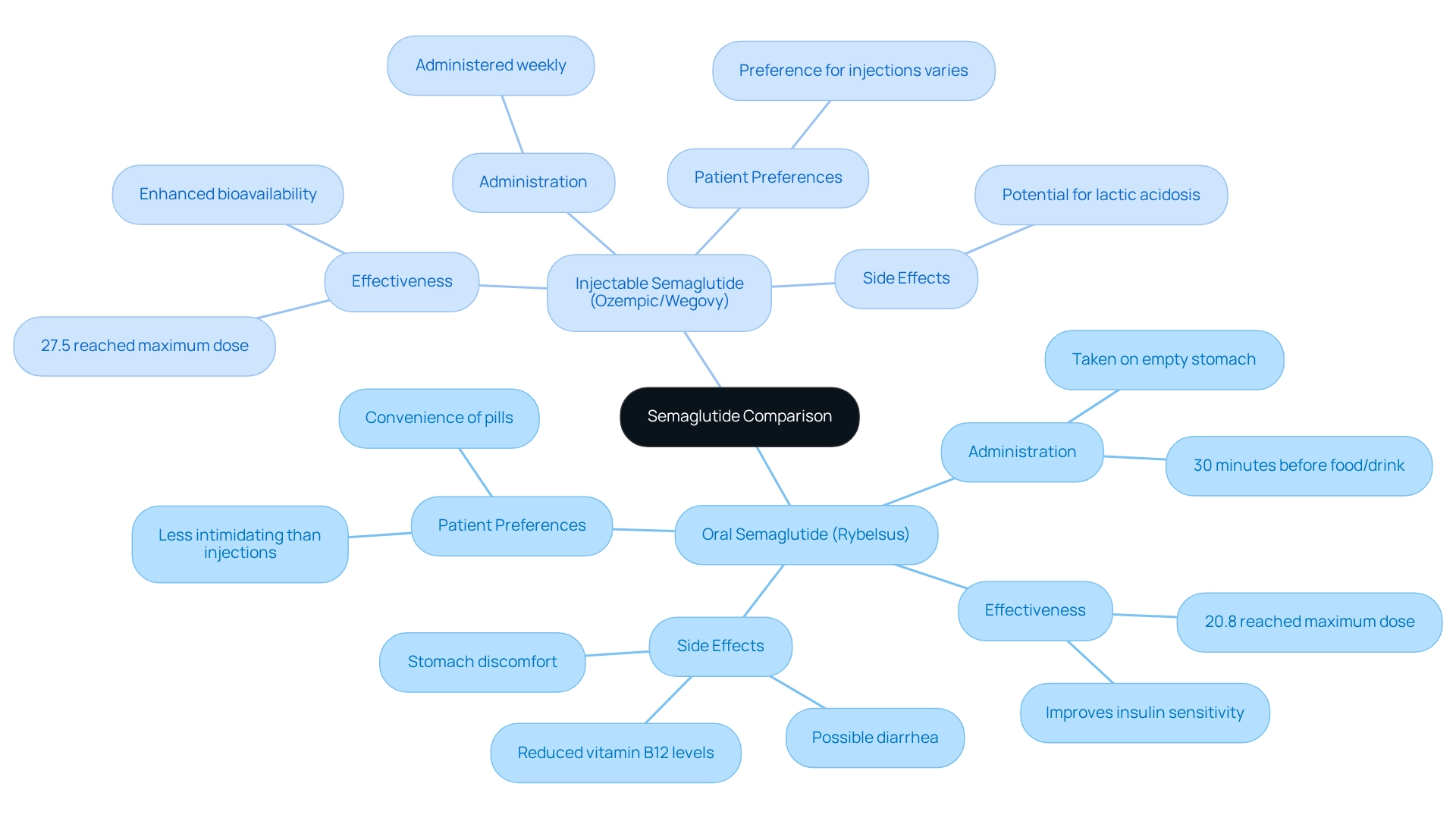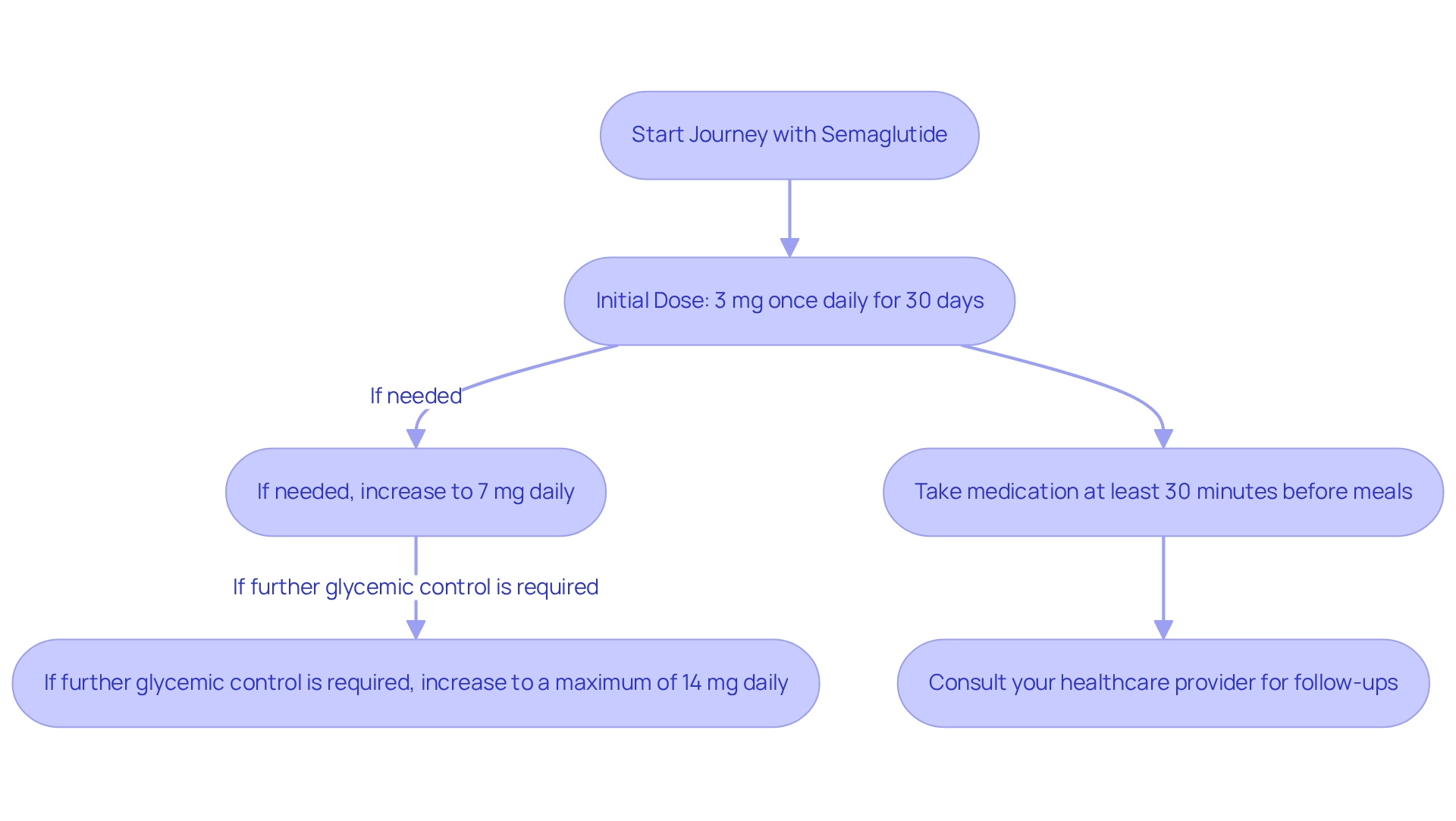Overview
This article highlights the important role of semaglutide oral tablets in weight management and type 2 diabetes treatment. If you’re feeling overwhelmed in your weight loss journey, know that you’re not alone. Semaglutide can lead to significant weight loss and improved glycemic control, offering hope for many. However, it’s essential to be aware that some individuals may experience side effects like nausea and abdominal discomfort. This is why careful dosing and administration are crucial.
We understand that personalized treatment plans are vital, and working closely with your healthcare provider can make a significant difference. Together, we can navigate the complexities of your treatment and find the best approach for you. Remember, you’re taking a positive step forward, and with the right support, you can achieve your goals. We’re here for you every step of the way.
Introduction
In the journey of managing diabetes and achieving weight loss, semaglutide stands out as a groundbreaking option that marries efficacy with convenience. This glucagon-like peptide-1 (GLP-1) receptor agonist not only boosts insulin secretion and reduces glucagon levels but also plays a vital role in facilitating significant weight loss. With solid clinical evidence backing its effectiveness, semaglutide presents a dual advantage for those facing the challenges of type 2 diabetes and obesity.
As you consider your options between oral and injectable forms, it’s essential to understand the nuances of dosing, administration, and potential side effects. This article aims to explore the mechanisms, comparisons, and important considerations surrounding semaglutide, providing a comprehensive overview for individuals like you who are seeking effective solutions for your health challenges. Remember, together, we can navigate this path toward better health.
Overview of Semaglutide: Mechanism and Uses
If you’re feeling overwhelmed by your weight loss journey, you’re not alone. Semaglutide oral tablets, which are a glucagon-like peptide-1 (GLP-1) receptor agonist, offer a supportive solution that mimics the GLP-1 hormone, playing an essential role in glucose metabolism. By binding to GLP-1 receptors, this medication enhances insulin secretion in response to meals, reduces glucagon secretion, and slows gastric emptying.
This multifaceted action not only improves glycemic control but also promotes significant loss of mass, making it a valuable option for those with type 2 diabetes and individuals seeking long-term management of their mass, particularly with semaglutide oral tablets, as clinical studies, including one listed on ClinicalTrials.gov (NCT03693430), have shown that patients using semaglutide oral tablets, especially when combined with lifestyle changes, can achieve a reduction of 10% or more in body mass.
Isn’t that encouraging? Recent research highlights that semaglutide oral tablets are associated with clinically significant and lasting reductions in body mass, along with improvements in cardiometabolic risk factors that are vital for your overall health.
While semaglutide oral tablets provide many advantages, it’s important to consider potential side effects such as:
- Nausea
- Abdominal discomfort
- Lowered vitamin B12 levels with prolonged use
However, the high adherence rates noted in clinical trials reinforce the efficacy of semaglutide oral tablets as a long-term solution for managing body mass. Together, we can explore this option, solidifying the status of semaglutide oral tablets as a top choice among GLP-1 receptor agonists. Remember, we’re here for you on this journey, and with the right support, achieving your goals is within reach.
Comparing Oral Semaglutide to Injectable Forms
Semaglutide oral tablets provide a convenient alternative to injectable options like Ozempic and Wegovy. Both formulations effectively manage blood sugar levels and support weight loss, yet they differ significantly in how they are administered and absorbed. Rybelsus must be taken on an empty stomach, at least 30 minutes before any food or drink, to maximize its absorption. In contrast, injectable medication is administered weekly, which may help maintain more stable blood levels over time.
Studies suggest that while both types are effective, the injectable variant often results in more significant weight loss for certain individuals due to its enhanced bioavailability. For instance, data shows that 27.5% of patients reached the highest dose of the subcutaneous medication, compared to 20.8% for the oral form. This difference highlights the potential for injectable medication to yield more substantial outcomes in managing body mass.
Patient experiences further underscore the appeal of oral medication. Many individuals prefer the simplicity of taking a pill over injections, which can feel intimidating or inconvenient. As Dr. Chance Miller notes, “Clients appreciate the personalized attention from a dedicated care team, which includes physicians like Dr. Chance Miller, who emphasize transformative care.” This personalized approach is crucial, as healthcare providers stress the importance of individualized treatment plans tailored to each patient’s needs.
In addition to its advantages, semaglutide oral tablets effectively lower blood sugar levels in individuals with type 2 diabetes, aid in weight management by enhancing insulin sensitivity, and reduce the risk of heart disease and other diabetes-related complications. It also improves long-term A1C levels for better glucose control. However, it’s essential to be aware of potential side effects, including stomach discomfort, possible diarrhea, and reduced vitamin B12 levels with long-term use. Rare but serious risks, such as lactic acidosis, should also be considered.
Experts have observed that oral medication fills a vital niche in diabetes and obesity treatment, offering similar benefits to its injectable counterparts while being more accessible for those who prefer oral options. When evaluating treatment alternatives, it’s important to note that insurance coverage for this medication varies based on specific plan policies, making it crucial to check the formulary. As healthcare providers emphasize, consulting with them to create a personalized treatment strategy based on chronic medical issues and other medications is vital. The decision between Rybelsus and injectable options should be made in collaboration with a doctor, considering each patient’s unique health circumstances and preferences. Together, we can navigate this journey towards better health.
Dosing and Administration of Semaglutide Oral Tablets
Starting your journey with medication can feel overwhelming, but we’re here to guide you every step of the way. The suggested initial dose of semaglutide oral tablets is 3 mg once daily for the first 30 days. After this initial period, you may find that increasing the dosage of semaglutide oral tablets to 7 mg daily can help, and if you need further glycemic control, the dosage of semaglutide oral tablets can be escalated to a maximum of 14 mg daily. Remember, it’s essential to take your medication at least 30 minutes before your first meal of the day, accompanied by a sip of plain water (not exceeding 4 ounces). To maintain the effectiveness of the medication, try to avoid consuming other liquids or food during this time.
Regular follow-ups with your healthcare provider are crucial for monitoring your progress and adjusting the dosing regimen as needed. We understand that navigating this process can be challenging, but know that you are not alone. Additionally, Wegovy, an FDA-approved medication, plays a vital role in regulating appetite and food consumption, which can aid in effective weight management and enhance your metabolic health. It’s important to note that Wegovy is administered via injection, and rotating injection sites can help avoid irritation.
If you have any medical questions or concerns regarding the medication, please consult your healthcare provider. Their guidance is invaluable in this journey. With Minimal’s personalized health programs, you can expect improvements in weight management, fitness levels, and overall well-being. Together, we can achieve your goals, and we are here to support you every step of the way.
Understanding Side Effects and Precautions
Navigating the journey with Wegovy can bring about challenges, particularly in the form of gastrointestinal issues such as nausea, vomiting, diarrhea, abdominal discomfort, and constipation. It’s important to note that research shows 99.5% of gastrointestinal adverse events reported were non-serious, with 98.1% classified as mild to moderate in severity. Nausea tends to be the most common gastrointestinal event, especially during the dose-escalation period, but rest assured, these symptoms often improve as your body adjusts to the medication. Staying hydrated and making dietary changes, like opting for smaller, more frequent meals, can significantly ease these effects.
While many side reactions are manageable, it’s essential to be aware that Wegovy carries warnings for potential serious conditions, including pancreatitis and thyroid tumors. If you have a history of medullary thyroid carcinoma or multiple endocrine neoplasia syndrome type 2, it’s crucial to avoid this medication altogether. Regular check-ins with your healthcare provider can help ensure your safety and the efficacy of your treatment.
Wegovy is administered through a simple subcutaneous injection once a week, using a pre-filled pen. You can easily inject it into your thigh, abdomen, or upper arm. Recent findings highlight that the use of semaglutide oral tablets, particularly at a dose of 2.4 mg weekly, combined with lifestyle changes, can lead to significant reductions in excess body mass or obesity. Those who have used Wegovy alongside a lower-calorie diet and increased physical activity have reported remarkable weight loss and positive changes in body composition, including reductions in total fat mass and visceral fat, while enhancing lean body mass. This emphasizes the importance of ongoing support and open communication with your healthcare team to manage any side effects effectively and to optimize your treatment outcomes.
The growing popularity of semaglutide is evident, as it stands out as a top seller in Medicare Part D plans, reflecting its significance in current health discussions and its role in personalized weight loss solutions. Remember, together, we can achieve your goals, and we’re here for you every step of the way.
Conclusion
Semaglutide emerges as a powerful ally in your journey against type 2 diabetes and obesity, offering a multifaceted approach to managing these health challenges. By mimicking the GLP-1 hormone, it enhances insulin secretion, reduces glucagon levels, and promotes weight loss. This versatility makes it a promising option for those seeking effective treatment. Both oral and injectable forms have shown significant efficacy, with studies highlighting the potential for substantial weight reductions and improvements in cardiometabolic health.
When considering your options, the choice between oral semaglutide, known as Rybelsus, and its injectable counterparts, such as Ozempic and Wegovy, ultimately comes down to your preferences and the guidance of your healthcare provider. While oral semaglutide offers convenience, injectable forms may yield more pronounced results in weight management due to higher bioavailability. It’s important to understand the nuances of dosing, administration, and potential side effects as you navigate your treatment effectively.
As you embark on your journey towards better health, remember that consulting healthcare providers is invaluable. Personalized treatment plans that consider your unique circumstances and preferences play a vital role in optimizing outcomes. Semaglutide stands out not only for its clinical effectiveness but also for its potential to transform lives. Together, we can achieve your goals in the ongoing battle against diabetes and obesity.
Frequently Asked Questions
What are semaglutide oral tablets and how do they work?
Semaglutide oral tablets are a glucagon-like peptide-1 (GLP-1) receptor agonist that mimics the GLP-1 hormone, which is important for glucose metabolism. They enhance insulin secretion in response to meals, reduce glucagon secretion, and slow gastric emptying.
What benefits do semaglutide oral tablets provide for weight loss?
Semaglutide oral tablets improve glycemic control and promote significant weight loss. Clinical studies have shown that patients can achieve a reduction of 10% or more in body mass, especially when combined with lifestyle changes.
Are there any health improvements associated with semaglutide oral tablets?
Yes, recent research indicates that semaglutide oral tablets are linked to clinically significant and lasting reductions in body mass, as well as improvements in cardiometabolic risk factors that are important for overall health.
What are the potential side effects of semaglutide oral tablets?
Potential side effects include nausea, abdominal discomfort, and lowered vitamin B12 levels with prolonged use.
How effective are semaglutide oral tablets as a long-term solution for weight management?
Clinical trials have shown high adherence rates for semaglutide oral tablets, reinforcing their efficacy as a long-term solution for managing body mass.



















